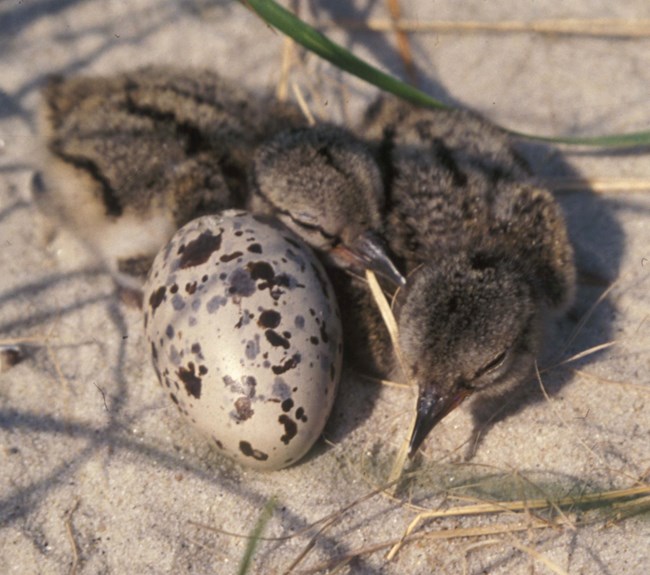
NPS Photo/Joey Negreann Description The American oystercatcher (Haematopus palliatus) is 17 to 21 inches in length making it a large, thick-set shorebird with a 35-inch wingspan. It has a black head and neck, dark back with white on its belly and white patches on its wings and tail. This shorebird has a large, straight, bright red-orange bill and adults have yellow eyes with an orange orbital ring while juveniles have dark eyes and orbital rings. Distribution and Abundance Along the Atlantic Coast American oystercatchers are found in North America along the Atlantic coast from Massachusetts south. While they do not breed along the Pacific coast, they can be found there along with black oystercatchers. They can inhabit South America year-round. American oystercatchers are increasing in abundance in Massachusetts due to the species expanding its range farther north in response to climate change and availability of habitat. They were first documented in Massachusetts in 1969 but it is believed that they are now attempting to re-occupy space lost sometime after European colonization. In 2011 a statewide census reported 418 adults and 202 pairs at 110 sites in Massachusetts. American oystercatchers were first recorded nesting on Cape Cod National Seashore beaches in 2002. There have been up to five pairs recorded in one year and their typical nesting sites are Jeremy Point, Coast Guard Beach in Eastham, and New Island. At the Seashore in 2022, three pairs of American oystercatchers laid six nest attempts at Jeremy Point. One nest successfully hatched chicks but they were lost soon after hatching. Jeremy Point is a highly dynamic environment with regular over wash events throughout the breeding season due to the low-lying nature of the sand spit it consists of. There is also very little cover in the area, therefore eggs and chicks can become an easy target for predators like coyotes and crows. Fortunately, American oystercatchers are long lived species and can sustain their population numbers with generally low productivity with occasional high productivity once every 7 to 10 years. Breeding and Feeding Habits American oystercatchers nest above the high tide line on the upper portions of sandy or gravelly beaches, on low ridges within salt marshes, or at the edges of salt marshes. The pairs are monogamous and can maintain a pair bond for many years in a row. Courting birds will pace quickly over the sand in unison, making a piping call that increases the tempo, and pivoting in arcing patterns across the beach, occasionally flying up in pairs. This is referred to as the Piping Ceremony. The female chooses the nest site. American oystercatchers keep the nest very minimal using a scrape in the sand without any lining. This species will incubate 2 to 4 eggs in one clutch during a 24 to 28 day incubation period. The active and coordinated young will leave the nest within one day of hatching covered in tan down. The chicks will fledge at approximately 35 days old and most stay with their parents through migration. This species spends its time feeding on intertidal flats, on lower portions of beaches, and at edges of salt marshes. In these areas, they are searching for oysters, mussels, clams, marine worms, crabs, and other marine invertebrates. Oystercatchers employ their long, knife-like bills to catch shellfish by jabbing their bill into the open shell of an unsuspecting mollusk, aiming to sever the strong muscle that would otherwise clamp the two halves of the mollusk shut. They can also use a “hammering” technique where they slam a bivalve against a rock at a carefully calculated point where the adductor muscle is protected inside. A few strong hits will cause the shells to crack open so the oystercatcher can sever the muscle and have a well-earned meal. 
Photo/United States Fish and Wildlife Threats The threats that face American oystercatchers and other shorebird species include increased predation, including by coyotes, crows, and gulls. They also face habitat loss due to climate change and costal development by humans. The areas inhabited by American oystercatchers are also popular location for recreation by humans which can lead to negative interactions and disturbance. This species is very intolerant of disturbance. Climate change causing sea-level rise and increased storm frequency and intensity are also changing the beach ecosystem. This includes storms and high tides that can flood nesting areas, decreasing the chance of egg and hatchlings survival. Projections of sea-level rise are accompanied by predictions of steep population declines without management interventions. American oystercatchers have gained some with the appearance of sand islands created from dredging spoils. These islands are usually isolated from mammalian predators and high enough above the water to create a safe nesting habitat. Protections American oystercatchers are designated as a “Species of High Conservation Concern” by the U.S. Shorebird Conservation Plan. The United States Fish and Wildlife Service defines this as “species that are not highly imperiled. Populations of these species are known or thought to be declining and have some other known or potential threat as well.” American oystercatchers are also protected under the Migratory Bird Treaty Act of 1918, which prohibits the take (including killing, capturing, selling, trading, and transport) of protected migratory bird species without prior authorization by the Department of Interior U.S. Fish and Wildlife Service. Cape Cod National Seashore helps to protect critical breeding habitat and migration stop-over areas for many species of shorebirds. The protections allow these species a place to rest and a place to raise their next generations. Things You Can Do to Help Protect American Oystercatchers and Other Shorebirds
American Oystercatcher (mass.gov) |
Last updated: January 31, 2023
